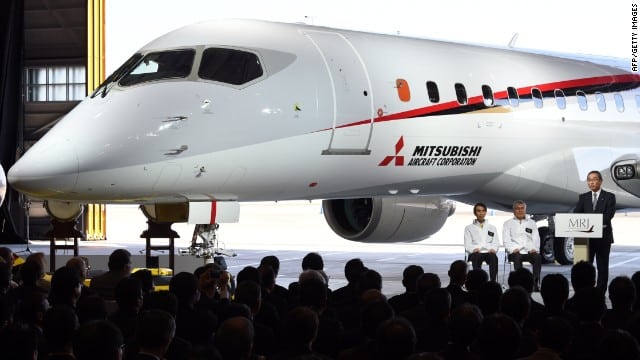Aerospace
After 50 years it has made Heroic Entry in Commercial Aircrafts.

Japan’s first domestically-built airliner in 50 years, and Launch was started by Taiko traditional drummers to pound away in a cavernous hanger is one way to create a loud noise to showcase in Global aviation industry. But Mitsubishi Aircraft, an aerospace firm, it already had the world’s attention long before it unveiled the Mitsubishi Regional Jet (MRJ),
Japan is made to set its mark in the skies with its first new commercial jet in more than 50 years, the Mitsubishi Regional Jet, or MRJ. Since Japan’s last commercial passenger plane was flying routes across the nation, the country has upgraded the world in high-speed rail and established a significant aerospace industry in Japan — but it’s taken a back seat when it comes to original aircraft development. That’s set to change with the narrow-bodied MRJ.
It was rolled out and made its press meet appearance at Saturday’s launch event, complete with a stirring taiko drum performance at the Komaki Minami plant in Nagoya, where one of Mitsubishi’s most famous aircraft was developed: the A6M “Zero” World War II fighter plane.
The last commercial Japanese plane to operate was Mitsubishi’s YS-11, a turboprop aircraft built between 1962 and 1972. It had been hoped the YS-11 would revive the Japanese aviation industry, but only 180 were sold, 99 of them in Japan.
The project to develop the MRJ began in 2008. Speaking at the event, Hideake Omiya, chairman of Mitsubishi Heavy Industries, said numerous problems and impediments had to be overcome during the plane’s development. “We had to be prepared to bear the risk that could jeopardize our company’s foundation. Going forward this jet will fly to every corner of the world. This is the moment of dreams come true.”
Composites are used in the construction of the MRJ, which will be powered by two Pratt & Whitney PW1200G engines. The jet will be available in two iterations, the 70-seat MRJ70 and 90-seat MRJ90. It has a pointed nose that wouldn’t be out of place on a bullet train. ANA is the launch customer for the four-seats-abreast plane, with 15 firm orders. At the rollout event on Saturday,
Shinichiro Ito, president and CEO of ANA, has mentioned the company is “determined to help ensure the MRJ becomes an aircraft loved and appreciated by our passengers.” Five MRJs will begin test flights in the second quarter of 2015, with commercial operations set to launch in 2017. Going up against Embraer and Bombardier in the narrow-bodied-jet sector, Mitsubishi says six airlines have more than 400 MRJ planes on order or with options to purchase: ANA, JAL, Air Mandalay, Sky West, Trans States, and a relaunched Eastern Air Lines.
Japan Airlines Limited said it has reached a basic agreement with Mitsubishi Aircraft Corporation to purchase new 32 Mitsubishi Regional Jets (MRJ) as the next-generation regional jets for our fleet (for JAL Group). We plan to deploy them on domestic routes from 2021, operated by J-AIR of JAL Group. JAL president said “I visited the factory where it is currently being developed. On seeing the new Japanese passenger aircraft with my own eyes, my heart beated fast and I was confident that it would be the perfect next-generation regional jet for our company.
This will be the first time for JAL Group to own a Japanese passenger aircraft since the times the former JAS Group operated the YS-11. In addition to deploying the MRJ, we will provide overall support using our know-how as an airline operating regional jet, and thus contribute to the birth of a Japanese passenger jet which we can boast about to the world.
MRJ president said As you may know, the MRJ is a regional jet developed by Mitsubishi Aircraft Corporation as the first Japanese passenger aircraft. Delivery of the first MRJ is scheduled in 2017. The MRJ is installed with new engines, which is going to be offer high economic performance and greater fuel savings than aircraft of the same dimensions. We will use the MRJ as the flag fleet for JAL Group’s regional network route operations.
The first test flight is planned next spring, and development is going smoothly for the delivery of the first MRJ in 2017. I believe that we can take our first delivery of the MRJ in best conditions in 2021.JAL group was announced
Mitsubishi has already received 230 orders for the new aircraft. Mitsubishi has long built parts for Boeing and assembled American military aircraft under contract. But some analysts have questioned Mitsubishi Aircraft’s ability to design and build a whole plane by itself. Much has been made of the fact that it once made the legendary Zero wartime fighter, but that was over seven decades ago. Japan was banned from having anything to do with aviation after the second world war and took until 1962 to develop the NAMC YS-11 regional airliner, a project that eventually failed due to spiralling costs.
That is possible. Unlike the messy consortium of independent-minded firms that built the last attempt, a single company is responsible for the MRJ project. And a great deal of national prestige has been invested in it. The government has contributed several billion yen toward the plane’s research and development, Toyota is a partner and All Nippon Airlines was first to order. The hopes and prayers of a lot of companies are invested in the project. That makes failure difficult to contemplate.
http://www.youtube.com/watch?v=PJdkbXbbgH4
Report courtesy : Mitsubishi press , Economist , CNN
Picture courtesy : app Gatty images , Japan.

Aerospace
Which is bigger 777x or 787 aircraft ?

The 777X is a new series of the Boeing 777 family and is designed to be larger and more efficient than its predecessor. It features two variants: the 777-8 and the 777-9, being the larger of the two.
The Boeing 777X emerges as the larger sibling within the Boeing family, representing a significant leap forward in both size and efficiency. Comprising two variants, the 777-8 and the 777-9, the latter takes the crown as the larger of the two. With its expansive fuselage and impressive wingspan, the 777X is tailored for long-range journeys and boasts a substantial passenger capacity.
On the other hand, the Boeing 787, affectionately known as the Dreamliner, occupies a niche in the market as a smaller yet formidable aircraft designed for medium to long-range flights. Its distinguishing feature lies in its composite fuselage, a technological marvel that renders it lighter and more fuel-efficient compared to conventional aluminum counterparts. The Boeing 777X is larger than the Boeing 787 aircraft.
When it comes to passenger capacity, the 777-9 reigns supreme, typically accommodating a sizeable contingent of 400-425 passengers in its standard configuration. In contrast, the 787, with its more modest dimensions, typically carries between 240-290 passengers, depending on the variant and layout.
One of the remarkable innovations introduced with the 777X is its folding wingtips, a feature designed to address the logistical challenges of accommodating such a large aircraft in conventional airport gates. These folding wingtips enable the 777X to retract its wings, allowing it to fit into gates designed for smaller aircraft while still reaping the benefits of an extended wingspan during flight, thereby enhancing fuel efficiency and operational flexibility
Aerospace
China Secures Production Certificate for Mass Production of Pilotless eVTOL Aircraft

The first passenger-carrying pilotless electric vertical takeoff and landing (eVTOL) aircraft in the world, the EH216-S, has received the Production Certificate for its eVTOL aircraft from the Civil Aviation Administration of China (CAAC).
This is a significant milestone for EHang Holdings Limited, the leading UAM technology platform company in the world. This outstanding accomplishment is another big step towards mass manufacturing for the eVTOL aircraft and the ensuing commercial operations, building on the ground-breaking acquisition of the Type Certificate and the Standard Airworthiness Certificate for the EH216-S.
The PC is a crucial certificate that the aircraft maker receives from the CAAC, the country’s aviation authority. By obtaining this certificate, EHang has demonstrated that it has set up a quality management system for mass production that satisfies the airworthiness regulation standards set forth by the CAAC, and the company has been given permission to continue producing mass quantities.
It is also a strong guarantee of the calibre of the goods made by EHang. Raw materials, supplier management, manufacturing organisation, production quality control, aircraft pre-delivery test, after-sales repair and maintenance, etc. are all included in the mass production quality management system for the EH216-S.
To ensure that every aircraft and its components that roll off the production line strictly adhere to the approved type design and safety requirements, the system sets clear guidelines and documentation for every step in the production procedure. This ensures comprehensive traceability and safety control.
Aerospace
Four Airbus A380 Superjumbos lined up to be scrapped

In a strategic move aimed at reclaiming valuable resources from the iconic Airbus A380 aircraft, VAS Aero Services and Dr. Peters Group have announced a significant collaboration.
This partnership marks a milestone in aviation logistics and aftermarket services, with four of these colossal planes slated for teardown and redistribution of used serviceable material (USM).
The venture between VAS Aero Services, renowned for its expertise in aircraft dismantlement, and Dr. Peters Group, a prominent Germany-based investment fund management firm, underscores a commitment to sustainable aviation practices. This isn’t their first foray into scrapping A380s; their successful partnership has already seen the dismantlement of these aircraft, making them pioneers in this niche.
Under the agreement, the latest consignment brings the tally to eight A380s entrusted to VAS by Dr. Peters Group. Managing Director Christian Mailly of Dr. Peters Group emphasized the trust placed in VAS, citing their unparalleled capabilities in dismantlement and aftermarket sales network. It’s a strategic move in response to the growing demand for quality USM parts, particularly with the resurgence in reliance on the A380.
Notably, the teardown process will be carried out at various locations, optimizing the positioning of harvested parts to cater to different markets. While some parts will be positioned in Europe to support operators in the region and the Middle East, others will remain in the Asia-Pacific region. This meticulous strategy ensures efficient access to spare parts, benefiting MROs and airlines across these markets.
The decision to retire these A380s comes at a time when operators are reassessing fleet strategies amidst evolving market dynamics. Despite initial plans for quick retirement due to the emergence of more fuel-efficient alternatives, factors such as a rebound in long-haul demand and delays in new widebody deliveries have prompted operators to reconsider. The A380, with its unique capacity and capabilities, presents a practical solution for short-term capacity management.

























